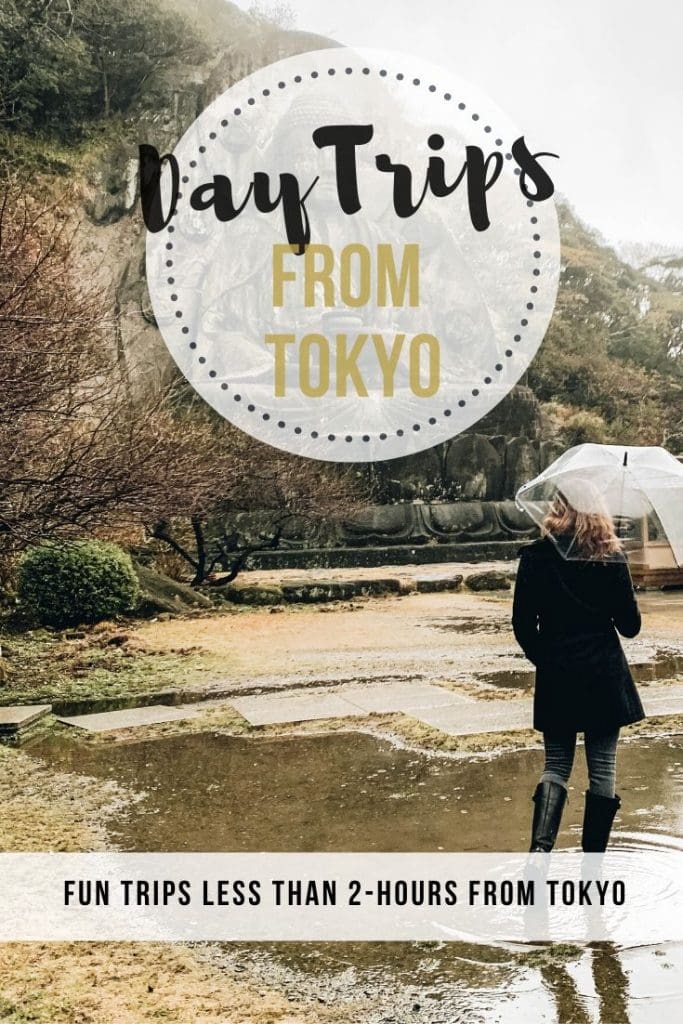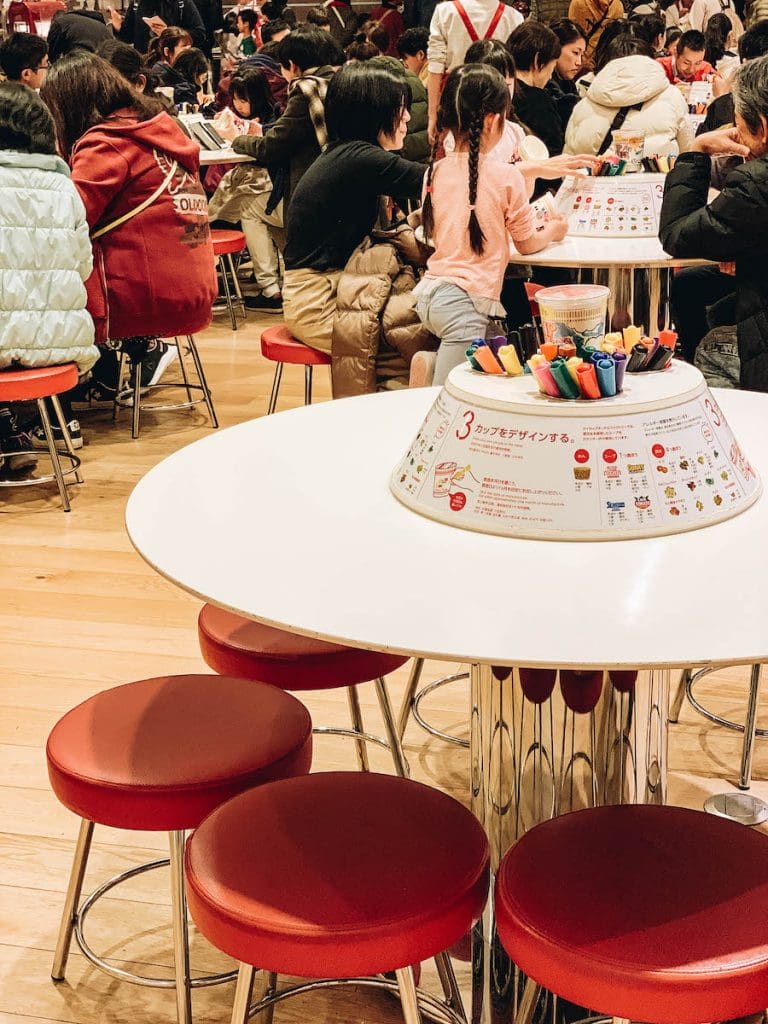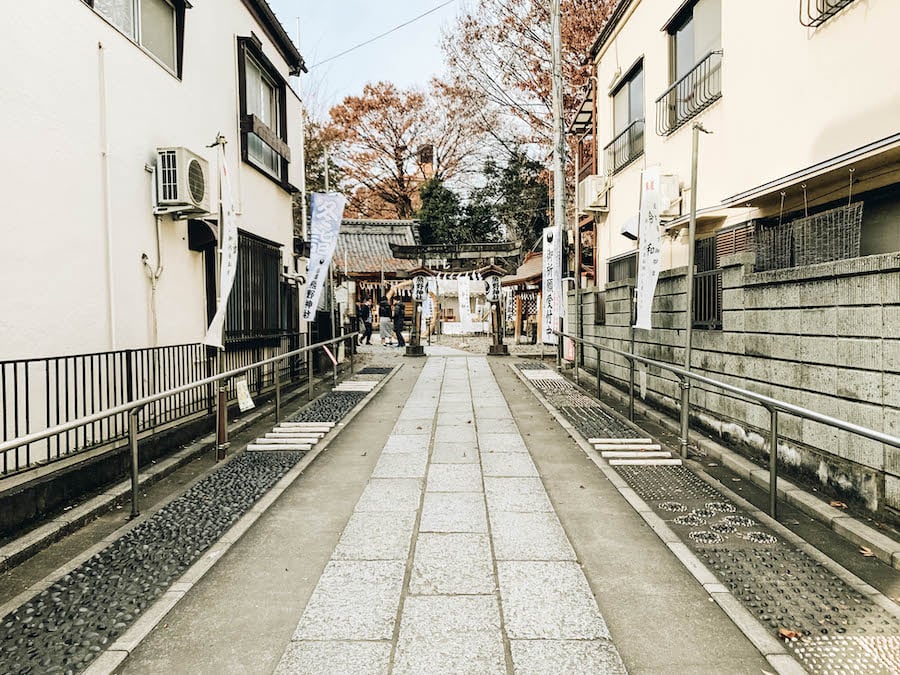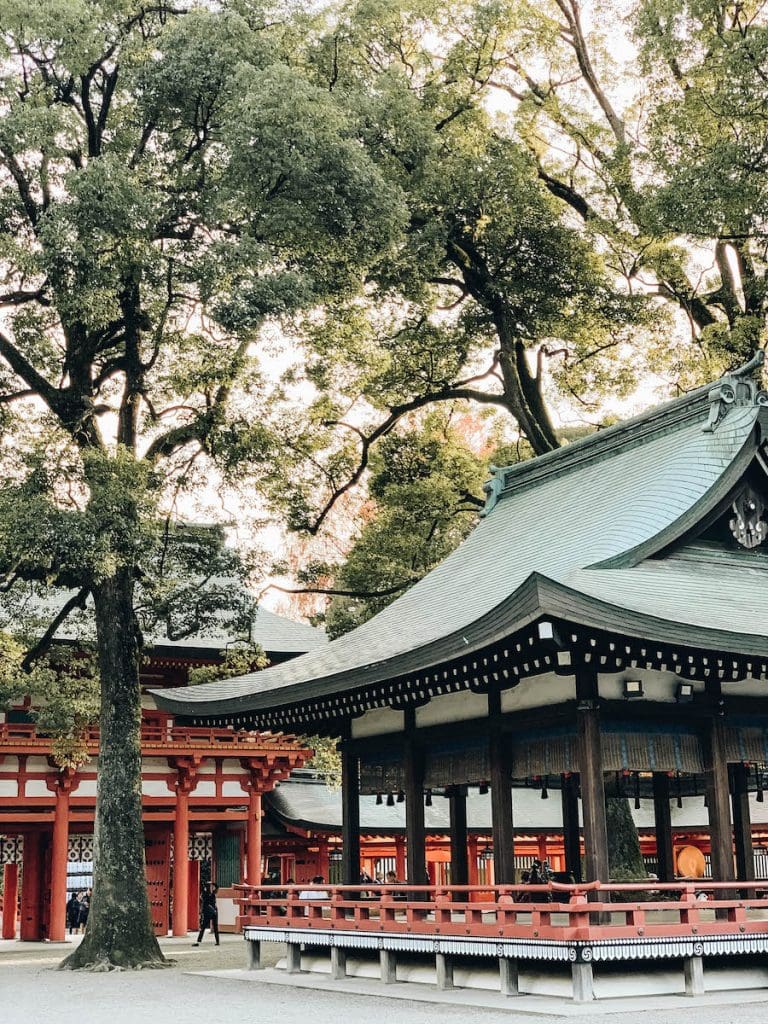It’s no secret that Tokyo is a tantalizing explosion for all the senses. It is a place where you can watch sumo wresters’ practice at a stable, belt out a song at a karaoke club, attend a show at the famous Robot Restaurant or eat fresh seafood at Tsukiji Fish Market. Though there is no shortage of fun things to do in Tokyo, you may want to escape the bustle of the big city to delve deeper into Japan, and you don’t have to go far to do it. The amount of day trips from Tokyo are plentiful, which make it the perfect base for any holiday. These best 4 are not only easy to get to, but also offer the perfect balance of Japanese tradition, outdoor adventure and delicious food.

4 of the Best Day Trips from Tokyo, Japan
Kanagawa Prefecture
Located just an hour southwest of Tokyo, the Kanagawa Prefecture draws visitors for its sandy beaches, lush nature and its port capital of Yokohama, Japan’s second largest city.
How to Spend Your Day Trip from Tokyo to Kanagawa Prefecture:
CupNoodles Museum
I’m a sucker for an interesting and interactive museum, and Yokohama has a great one! The four floors of the CupNoodles Museum offers the perfect combination of informational exhibits and activities. You can start your visit learning about Momofuku Ando’s life of food, and in particular his creation of the first ever ramen noodle cup. Then take a peek into the Instant Noodles History Cube that displays over 3,000 product packages, dating back to 1958. On that same floor, explore each of the six Creative Thinking Boxes that interactively teach the six key ideas that Ando uses in his process. My favorite of these was the Never Give Up box that teaches us to keep working towards our dreams no matter how many times we fail before achieving them.

There’s also a cafe and children’s play section, but nothing beats actually making your own cup of noodles. And it’s simple to do. After purchasing your cup from a vending machine, you sit at a design station and color it with your own style. Then bring it the the production line to be filled with ramen and your chosen base flavor (seafood, chili tomato, curry or the traditional cup noodles). The tricky part is picking four additional ingredients from the dozen available. There were things like corn, chicken and cheese. Your ramen then will be sealed, secured and ready for you to transport home. That’s it!




Enoshima Island
If you want your dose of vacation bliss, the sandy beaches and seafood at Enoshima Island are just what you need. At this small offshore island linked to the mainland by a bridge, you can enjoy the sun, sand and the sea along with shrines, shops and other lovely spots. Quite a few of the island’s attractions are atop a hill so a fair bit of walking is involved. But if you don’t want to climb, you can always take the escalator for which you have to pay a fee.
Shirasu Lunch / / Food is one of the highlights at Enoshima Island and for lunch you should indulge in the local tradition, shirasu. It is a whitebait fish that is served in many different ways, but the most desirable is raw. Shirasu dishes are served all over the island, but it may be the most popular at Tobiccho restaurant where there is almost always a line. They offer a few different options, but most order the shirasudon, which is a bowl of rice topped with mounds of the young fish.
FYI: They can only be served raw on the same day as catching them, so it’s best to visit during the prime season from April to December. Otherwise, you can just as easily order them boiled or marinated. I ordered a trio of them all and liked the marinated ones best!



Enoshima Island Shopping Street / / Upon arrival to Enoshima Island the bustling Benzaiten Nakamise street will lay right in front of you. Crossing through the symbolic bronze Torii gate will lead you to an array of fun souvenir boutiques, restaurants and stands offering local specialties like Manjū (and the not so traditional chestnut ice cream that I had!)



Enoshima Shrine / / The shopping street leads you to a fairly steep uphill path to the Enoshima Shrine, which will take you about 20 minutes to walk. Or opt to ride the very convenient escalator that will get you there in just over four. Three different shrines on the island actually make up the Enoshima Shrine—Hetsumiya, Nakatsumiya, and Okutsumiya. The three shrines are within close walking distance of each other and offer an interesting insight into culture and religion.



Samuel Cocking Garden / / This pretty Samuel Cocking Garden is at the top of Enoshima Island, and you don’t want to miss it! You can stroll through to explore the many varieties of plants and flowers that bloom through the year. Then make your way to the Enoshima Sea Candle, an observation tower where on a clear day you can see Mt. Fuji.
During the holiday months the gardens have a spectacular light show where at exactly 5:00 they flip a switch and hundreds of thousands of lights turn on. It was one of the most spectacular things I’ve seen in Japan.



Yokohama Harbor
Enjoy the lights reflections on the water while walking along the Yokohama City harbor, ogle the Red Brick Warehouse and then take a ride on the ferris wheel. It actually holds a Guinness World Record for being the largest ferris wheel with a clock! The 15-minute ride will give you 360-degree views of Yokohama.

Dinner & Drinks in Noge
Noge, or Nogecho, is a casual section of Yokohama where the streets are packed with izakaya pubs, small bars and jazz clubs. You can pop into almost any of the restaurants here for a great meal, but we ate at Shokai and it was delicious. It was a small bar with a handful of tables and served the best fried chicken nuggets I’ve ever had. Plus, if you are an adventurous eater, they also have a variety of horse meat dishes on the menu (a Japanese tradition).



This is a pretty busy Tokyo day trip itinerary, so if you like to move at a slower pace then consider spending the night in Yokohama. I stayed at The Hotel New Grand which is a historical place built in 1927 and just a short distance from the harbor.

Saitama Prefecture
The Saitama Prefecture is another popular option for a day trip from Tokyo since it’s located only about a half hour to the north. The area has a lot to offer visitors, like the former castle town of Kawagoe, the Railway Museum, historic temples and shrines.
How to Spend Your Day Trip from Tokyo to Saitama Prefecture:
Kawagoe Kumano Shrine
The Kawagoe Kumano Shrine may be smaller than many in the area, but it is definitely worth a visit. While there you can remove your shoes to take the acupuncture walk made with stones and get your fortune told by one of the three crystal balls (though if you don’t speak Japanese you will need a translator to decipher what it is!). My fortune was “good luck will come when you learn from your mistakes”.


After the shrine we went to Shintoshin Station to rent bicycles so we could bike around the Omiya area. You can grab lunch at one of the many restaurants nearby, like Toyozushi or Serafina New York.
Omiya Bonsai Art Museum
Japan is famous for the Bonsai art form that involves growing tiny ornamental varieties of full-sized trees in containers. These miniature trees are cultivated using special watering, pruning, wiring and potting techniques to produce captivating results. The Omiya Bonsai Art Museum has an extensive collection of exhibits both indoors and outdoors,—70 trees showing and 120 all together! Inside some of these plants are displayed in traditional Japanese styled rooms, such as the Shin, Gyo and So. Outdoors, the walking pathways take you through a beautiful presentation of bonsai of all ages, one is estimated to be 1,000 years old. It’s not hard to be mesmerized by these pint-sized plants or to come away with a deeper understanding of them.

Omiya Hikawa Shrine
Yes, it’s true—shrines are everywhere in Japan, and each one has its own charm. Omiya is famous for its Hikawa shinto shrine founded more than 2000 years ago. Omiya actually means ‘great shrine’ and it is named after the remarkable Hikawa. The shrine, which is the largest one in Saitama, is located amidst a tranquil setting in the Omiya park. So, besides just the worshipping halls there is also a zoo and museum nearby.
Tip: There are many cherry blossom trees in the area, so try to time your trip during the season when you can see them beautifully in bloom.



Dinner at Koedo Kurari
Koedo Kurari has been renovated from a former sake brewery, which was founded in 1875 between the Meiji and Showa Eras, into a place where visitors and locals can enjoy the products of Kawagoe city. In the four converted buildings, you can explore the handful of souvenir shops featuring goods from the area, do a tasting at the sake brewery and indulge in handmade confectionaries. Afterwards have dinner at Taisho, a Japanese brewpub that specializes in local sweet potato dishes.



Fukushima Prefecture
Fukushima prefecture is about an hour and a half train ride north from the Tokyo, which makes it easily accessible. But, easy access is not the only reason visitors come here. Mountains, traditional villages and a deep samurai history make it one of the best day trips from the city.
How to Spend Your Tokyo Day Trip to Fukushima Prefecture:
Nisshinkan Clan School
If you have an interest in Samurais, make your way to the Aizu Hanko Nisshinkan, that used to function as a school for young members of Samurai families during the Edo period. It was one of the most revered institutions of its time! Young boys were trained at this school to become fierce Samurai warriors. They usually enrolled in the school at the age of ten and acquired knowledge of academics as well as physical and mental training.
On a visit to the museum, you will learn about the school life here and be told samurai stories of the Aizu Clan during the Boshin War especially that of the brave young warriors, the Byakotai. But there’s way more than just a history lesson at Nisshikan, you can also get a chance to practice some samurai disciplines including archery and martial arts, plus you can make your own akabeko, a legendary red cow from the Aizu region of Japan.



Ouchi-juku Village
After you’ve gotten a taste of samurai culture, head over to Ouchi-juku, a well-preserved and scenic village from the Edo period. The village was used as a transit point by feudal lords on their way to Edo city. Seeing the traditional structures with thatched roofs on both sides of the street gave me a feeling of traveling back in time. These buildings are more than 300 years old and have a quaint charm about them. To get the best view from above these amazing structures, head up the steep road to a hillside shrine from where you can see it all. On the way, you can also stop at shops and eateries, some of which serve handmade goods and other local delicacies.



Lunch in Ouchi-juku / / For lunch stop by Ouchijuku Misawaya for a bowl of their signature dish, takato soba that is served with a long green onion (negi) to eat with instead of chopsticks. I’m not going to lie, it was tricky!



Tsuruga Castle
Towards the end of the Edo Period, the Tsuruga Castle in Aizuwakamatsu turned into a battle site of the Boshin War. The castle was famous for the distinctive red-colored tiles on the roof containing iron. A samurai stronghold, it became well-known due to its role during the time of the Boshin war. But it was destroyed during the battle and later rebuilt. Today, it functions as a museum where you can learn all about Samurai history and lifestyle, the war and the castle itself. Definitely don’t miss climbing to the top floor for the amazing view and visiting the teahouse on the grounds.

If you decide to extend your day trip into overnight a stay at Harataki will not disappoint. This place is a traditional ryokan (Japanese inn) and onsen. There are four open-air baths there for you to enjoy!

Chiba Prefecture
Chiba’s close proximity to Tokyo and Narita Airport make it an ideal day trip. This prefecture has its fair share of natural beauty in the form of mountain peaks and stretches of sandy beaches, but it is also home to popular theme parks and interesting shopping destinations.
How to Spend Your Day Trip from Tokyo to Chiba Prefecture:
Hike Mt. Nokogiri Hiking and Sightseeing
It will be easy to spend quite a few hours of your day hiking and exploring the sites at Mt. Nokogiri (also called Sawtooth Mountain). The 1,079 foot mountain has a natural beauty on it’s own, so take your time exploring it, but it also home three major attractions not to miss:
001 // Hell Peek Point // A climb to the top of the mountain will lead you to Jigoku Nozoki, translated as the Hell Peek Point. This lookout is situated on a jagged rock that protrudes from the mountain. So, when you look down from above, all you can see is the deep plunge to the mountain floor below with nothing in between. As you stand on the edge of the rock, there’s just a railing between you and the ground below that may give a sensation that you are falling off. Once you get over the slightly scary feeling of standing on the rock, you can start enjoying the spectacular views of the surrounding areas.

002 // Hyaku-Shaku Kannon // Carved right into the cliffside in a deep gorge is the 30-meter tall Hyaku-Shaku Kannon, the Buddhist Goddess of Mercy. The carving was created in the 60s and is dedicated to those who have had unfortunate deaths.
003 // Nihonji Daibutsu (Big Buddha) // One of the main attractions at Mt. Nokogiri, is Nihonji Daibutsu, Japan’s largest sitting buddha. It was founded during the Nara Period, is 31 meters high and was built over 1300 years ago in 1783.
Those who want to add to this already bucket list worthy experience, can take the ropeway car to the top. For more information on Mt. Nokogiri and the ropeway see their brochure and area map.



Hota Shogakko
Once you are done with the hiking, you can indulge in a bit of eating and shopping at a quirky place not too far from the mountain known as Hota Shogakko. A former elementary school, Hota Shogakko has been converted into a shopping, eating, lodging and community events destination. The fun part is that many elements of the school have been kept intact in the design including blackboards, tables and chairs! So, go back to school for a couple of entertaining hours.
Definitely don’t miss eating at Da Pe Gonzo, where the pizzas are made in the wood-burning oven and combination meals are served on school lunch trays.

In Tokyo, you can enjoy the pulsating energy of the big city with all its attractions and the fast-paced life. And when you want to unwind, balance it out by going on day trips from Tokyo to all the amazing prefectures just a short distance away. It’s a great way to enjoy the best of both worlds!
This post may contain affiliate links. If you make a purchase through my links, I earn a commission that helps to keep this blog running—at no extra cost to you. For more information read my full disclosure.
You Might Also Enjoy
Japanese Food Bucket List: 70 Foods to Eat from Japan
Tokyo Bucket List: 50 Top Things To Do in Japan’s Coolest City
Best Quirky Café in Japan? Tokyo’s Calico Cat Café in Shinjuku
Shinjuku Nightlife: A Guide to Tokyo’s Best Golden Gai Bars
Tokyo Food: 13 Themed (& Slightly Weird) Cafe & Restaurant Experiences
Visit Tokyo’s Tsukiji Fish Market
Eat Chankonabe in Tokyo. Sumo Wrestlers Stew
Watch Wrestling Practice at a Sumo Stable in Japan
Play a Game of Pachinko in Japan
Attend a Baseball Game in Japan
Watch Wrestling Practice at a Sumo Stable in Japan
Eat at a Themed Restaurant in Tokyo
Participate in a Japanese Tea Ceremony
How to See a Japanese Baseball Game in Tokyo

This is a great list of one day trips from Tokio, I would be happy to visit the city itself and get immersed in the countryside of Japan.
If anyone visits Tokyo, then this is what they need to have a meaningful Tokyo tour.
Nice share
And I just noticed that you have visited Sri Lanka a couple of times back 2014 and 2016.
Come visit us again.
Things have changed a lot :D
Have a safe journey and keep inspiring
I did visit Sri Lanka a long time ago! I definitely need to go back.
This is a great way to visit a country. We like staying at least a month in an area and then take the day trips out and around. That way you get to see and experience so much more and don’t have to pack up everything to do it. Great post with interesting day trips to consider. Love the photos.
Thank you so much for sharing your experiences. My partner and I went to a few of these restaurants and were delighted with how amazing the food was!
Currently planning my Japan trip for when things reopening and I’ve really enjoyed all of your guides – thanks for creating all these comprehensive articles.